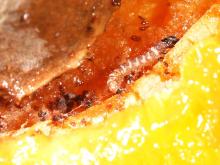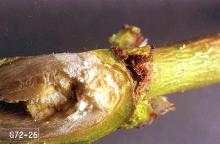Anarsia lineatella
Pest description and crop damage The peach twig borer is a European moth first found in California in the 1880s. It is a major pest of apricots, peaches, plums, and prunes. The adult is a gray moth with white and dark scales, about 0.3 to 0.5 inch in length. The larva is a caterpillar, about 0.5 inch in length, with a dark brown head and distinctive, alternating light and dark bands on the body. The pupa is smooth and brown. Larvae injure fruit and trees by feeding on the buds and twigs early in the season. Later in the season, the larva bores into the shoots causing a characteristic "flagging" or wilting of the new growth. Later generations of larvae feed on shoots or fruit, disfiguring the fruit. Flagging of twigs indicates an infestation.
Biology and life history The borer overwinters as an immature larva within tunnels constructed within the crotches of twigs and branches. These overwintering sites can be identified by the small chimneys of frass and wood fragments produced by the feeding of the larvae. Larvae become active by the pink bud stage and emerge to feed on buds and young leaves. Later the larvae will bore into shoots. These larvae eventually leave the mined shoots to pupate. Adults then emerge in mid-to-late May. Eggs are laid on fruit, shoots, or undersides of leaves. Eggs are yellowish white to orange. Eggs hatch, and emerging larva feed on shoots and immature fruit. The next adult flight is in mid-July. Some of the larvae from this flight overwinter, and the rest produce a partial third flight.
Pest monitoring Use pheromone traps to time sprays to target the young larvae before they bore into tissues. Scout for flagging of shoots early in the season. Detection indicates a need to protect the fruit from later generations of peach twig borer.
Management-cultural control
Cut out and destroy mined shoots below the wilted area to eliminate larvae. Overwintering larvae may be found and destroyed under thin bark in branch crotches. Look for a buildup of chewed bark and frass (excrement).
Management-chemical control
Early sprays aimed at the newly hatched larvae, before they bore into the shoot or fruit, will provide the best control of peach twig borer.
Management-chemical control: HOME USE
Dormant-season spray
- superior-type oil-Some formulations OMRI-listed for organic use.
Growing-season spray
For most effective control, target the young larvae with cover sprays during pre-bloom or petal fall.
Warning: Many pesticides are hazardous to bees. Look for bee precautionary statements on product labels and do not use these products during bloom or if bees are foraging in the orchard.
- carbaryl-Highly toxic to bees.
- gamma-cyhalothrin-Highly toxic to bees.
- kaolin-When sprayed on leaves, trunks, and fruit, kaolin acts as a repellant to some insects. Some formulations are OMRI-listed for organic use.
- lambda-cyhalothrin -Highly toxic to bees.
- pyrethrins-Highly toxic to bees. Some formulations may be OMRI-listed as organic.
- spinosad-Some formulations may be OMRI-listed as organic.
- zeta-cypermethrin-Highly toxic to bees.
Management-chemical control: COMMERCIAL USE
For the most effective control, target the young larvae with cover sprays during pre-bloom or petal fall.
Delayed-dormant and prebloom spray
Warning: Many pesticides are hazardous to bees. Look for bee precautionary statements on product labels and do not use these products during bloom or if bees are foraging in the orchard.
- horticultural mineral oil (rates vary, check product label) + carbaryl (Carbaryl 4L) at 4 to 5 quarts/A. REI 12 hr. Extremely toxic to aquatic invertebrates; avoid spray drift and runoff to surface waters.
- chlorantraniliprole (Altacor 35 WDG) at 3 to 4.5 oz/A (0.066 to 0.099 lb ai/A). REI 4 hr. May be applied with a registered horticultural mineral oil.
- phosmet (Imidan 70W) at 0.75 to 1 lb/100 gal water (4.25 lb/A). REI 7 days. Extremely toxic to fish; avoid spray drift and runoff to surface waters.
- spinetoram (Delegate 25WG) at 3.0 to 7 oz/A. REI 4 hr.
- spinosad (Entrust 80W) at 0.4 to 0.8 oz/100 gal water (1.25 to 2.5 oz/A). REI 4 hr. OMRI-listed for organic use. May act slowly.
Bloom spray
- Bacillus thuringiensis var. kurstaki-Formulations vary; check label for rates. REI 4 hr. Nontoxic to bees. This biologically derived material is slow acting and requires good coverage and multiple applications to be effective. Apply when forecast calls for warm daily temperatures. This acts as a stomach poison and is less effective during cool weather, when larvae are not actively feeding. Some formulations are OMRI-listed for organic use.
Petal fall, spring, and summer sprays
Warning: Many pesticides are hazardous to bees. Look for bee precautionary statements on product labels and do not use these products during bloom or if bees are foraging in the orchard.
- Bacillus thuringiensis var. kurstaki-Formulations vary; check label for rates. REI 4 hr. PHI 0 days. Nontoxic to bees. This biologically derived material is slow acting and requires good coverage and multiple applications to be effective. Apply when forecast calls for warm daily temperatures. This acts as a stomach poison and is less effective during cool weather, when larvae are not actively feeding. Some formulations are OMRI-listed for organic use.
- chlorantraniliprole (Altacor 35 WDG) at 3 to 4.5 oz/A (0.066 to 0.099 lb ai/A). REI 4 hr. PHI 10 days.
- methoxyfenozide (Intrepid 2F) at 8 to 16 fl oz/A. REI 4 hr. PHI 7 days.
- phosmet (Imidan 70W) at 0.75 to 1 lb/100 gal water (4.25 lb/A). REI 7 days. PHI 14 days. Extremely toxic to fish; avoid runoff and spray drift to surface waters.
- spinetoram (Delegate 25WG) at 4.5 to 7 oz/A. REI 4 hr. PHI 14 days.
- spinosad (Entrust 80W) at 0.4 to 0.8 oz/100 gal water (1.25 to 2.5 oz/A). REI 4 hr. PHI 14 days. OMRI-listed for organic use. May act slowly.





